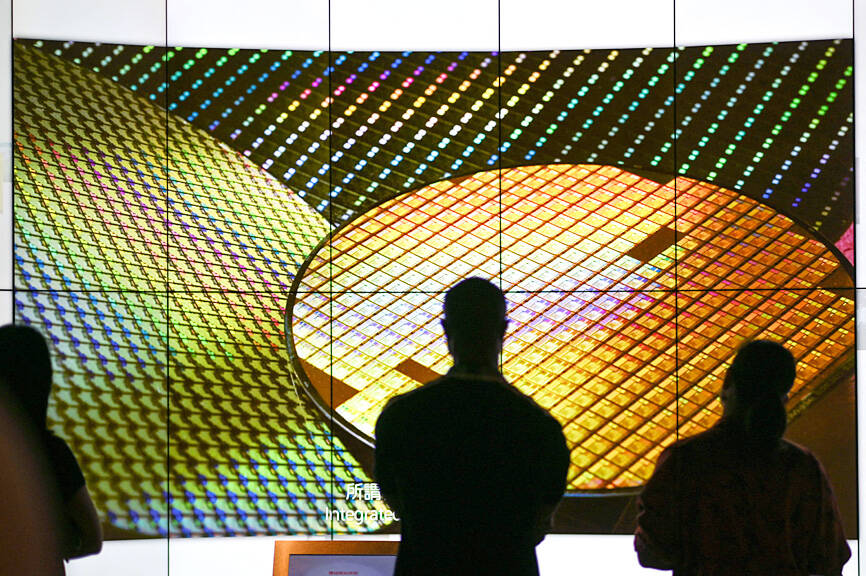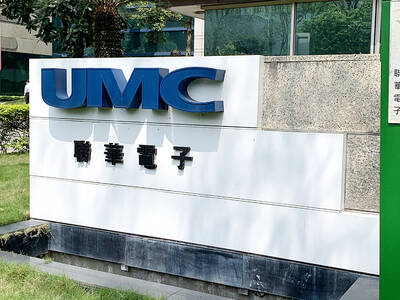Propelled by robust demand for artificial intelligence, high-performance computing and other emerging technology applications, the local integrated circuit (IC) sector’s production value should return to growth in the first quarter of this year after declining every quarter on an annual basis last year, the Ministry of Economic Affairs said yesterday.
Output slid 1.3 percent year-on-year to NT$943.8 billion (US$29.41 billion) in the final quarter of last year, albeit an improvement over the double-digit percentage declines in the previous three quarters, due to weak consumer electronics sales and supply-chain inventory adjustments, the ministry said in a report.
For the full year, production slumped 12.9 percent to NT$3.26 trillion last year, the second-highest on record after 2022’s NT$3.74 trillion, it said.

Photo: Sam Yeh, AFP
Due to a lower comparison base last year, the production value this year should show positive growth, it added.
Taiwan's IC sector boasts an advantage from an ecosystem within which different segments are supporting one another. Moreover, aided by continuous research and development, the sector’s production value grew for 11 consecutive years from 2012 to 2022, the ministry said.
The 12-inch wafer foundry segment leads the sector with its cutting-edge technology and global competitiveness, accounting for 68 percent of total IC output last year, the ministry said.
From 2012, the segment’s production value grew consistently, surpassing the NT$1 trillion mark in 2017 and hitting a record-high of NT$2.42 trillion in 2022, before retreating 8.4 percent to NT$2.22 trillion last year, it said.
The IC design segment ranked second, with output reaching NT$695.4 billion last year, or 21.3 percent of the total, it said.
As the IC design segment is positioned at the upper stream of the sector, it is sensitive to end-market demand and tends to be the first to signal changes in the semiconductor industry, the ministry said.
While other segments still posted declines, IC design’s output in the final quarter of last year reversed up 16.6 percent, it said.
The 8-inch and below wafer foundry segment ranked third in production value at NT$202.7 billion, accounting for 6.2 percent of the sector’s overall output, ahead of the DRAM segment’s NT$46.4 billion, or 1.4 percent of the total, the ministry said.

MAJOR BENEFICIARY: The company benefits from TSMC’s advanced packaging scarcity, given robust demand for Nvidia AI chips, analysts said ASE Technology Holding Co (ASE, 日月光投控), the world’s biggest chip packaging and testing service provider, yesterday said it is raising its equipment capital expenditure budget by 10 percent this year to expand leading-edge and advanced packing and testing capacity amid strong artificial intelligence (AI) and high-performance computing chip demand. This is on top of the 40 to 50 percent annual increase in its capital spending budget to more than the US$1.7 billion to announced in February. About half of the equipment capital expenditure would be spent on leading-edge and advanced packaging and testing technology, the company said. ASE is considered by analysts

TRANSFORMATION: Taiwan is now home to the largest Google hardware research and development center outside of the US, thanks to the nation’s economic policies President Tsai Ing-wen (蔡英文) yesterday attended an event marking the opening of Google’s second hardware research and development (R&D) office in Taiwan, which was held at New Taipei City’s Banciao District (板橋). This signals Taiwan’s transformation into the world’s largest Google hardware research and development center outside of the US, validating the nation’s economic policy in the past eight years, she said. The “five plus two” innovative industries policy, “six core strategic industries” initiative and infrastructure projects have grown the national industry and established resilient supply chains that withstood the COVID-19 pandemic, Tsai said. Taiwan has improved investment conditions of the domestic economy

Huawei Technologies Co’s (華為) latest smartphones carry a version of the advanced made-in-China processor it revealed last year, results from an independent analysis showed. This underscored the Chinese company’s ability to sustain production of the controversial chip. The Pura 70 series unveiled last week sports the Kirin 9010 processor, research firm TechInsights found during a teardown of the device. This is a newer version of the Kirin 9000s, made by Semiconductor Manufacturing International Corp (SMIC, 中芯) for the Mate 60 Pro, which had alarmed officials in Washington who thought a 7-nanometer chip was beyond China’s capabilities. Huawei has enjoyed a resurgence since

IMPROVEMENT EXPECTED: The company holds a cautiously optimistic view about this year, an official said, adding that an increase in wafer shipments is predicted United Microelectronics Corp (UMC, 聯電) yesterday reported its weakest quarterly net profit in three years, which it attributed to a prolonged inventory correction. However, the company said it expects wafer shipments to grow about 3 percent this quarter as demand from communication and computer segments is to pick up from last quarter. Net profit plunged 35.4 percent to NT$10.46 billion (US$321.6 million) in the first quarter of the year, compared with NT$16.18 billion a year earlier, making it the worst quarterly performance since the first quarter of 2021. On a quarterly basis, net profit declined 20.8 percent from NT$13.2 billion, the Hsinchu-based